Growth Degree Days
Growth Degree Days Project
Pests to Watch Out for by Growing Degree Days
Growing degree days (GDD), also called growing degree units (GDUs), are a heuristic tool in phenology. GDD are a measure of heat accumulation used by horticulturists, gardeners, and farmers to predict plant and animal development rates such as the date that a flower will bloom, a pest will emerge, or a crop will reach maturity.
-
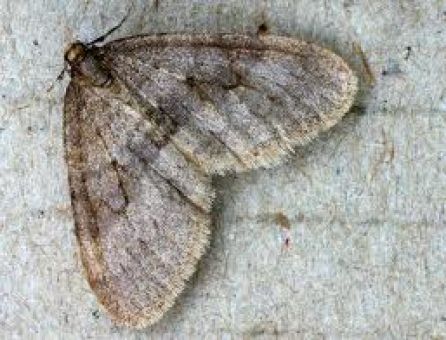 Winter Moth- Fifty-three readers responded in the affirmative when we asked if anyone had witnessed winter moth activity in a November-December 2013 informal survey.
Winter Moth- Fifty-three readers responded in the affirmative when we asked if anyone had witnessed winter moth activity in a November-December 2013 informal survey.GDD 1-50 Winter Moth
-
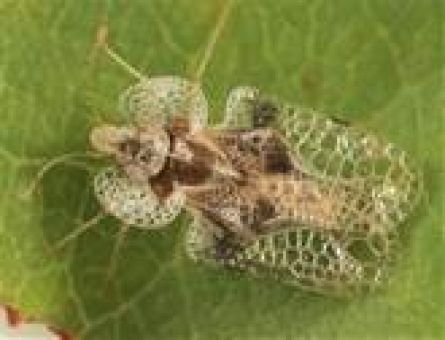
Lace Bugs- Nymphs will be feeding on underside of andromeda, azalea, rhododendron and other evergreen leaves causing loss of plant vigor. Drench plant thoroughly with insecticidal soap and/or neem.
GDD 1-170 Lace Bugs
-
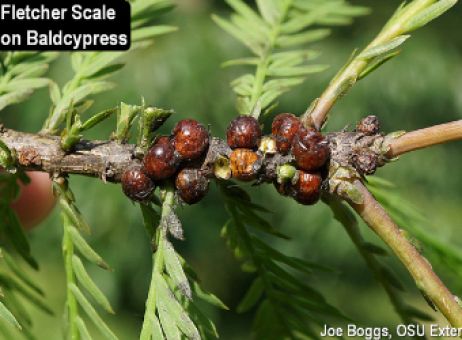
Scales are sucking insects with tube-like mouth-parts they insert into the leaves to extract the nutrient rich sap found within.
Scales too numerous to name individually will become active in May with the rise in temperature and GDD 30 – 150. Now is a good time to treat plants that may have been damaged by this pest in the past. Drench them with a horticultural oil or insecticidal soap. This will help to control the over-wintering scales (adult females) before they birth the next generation of crawlers later in the season.
GDD 30-150 Scales
-
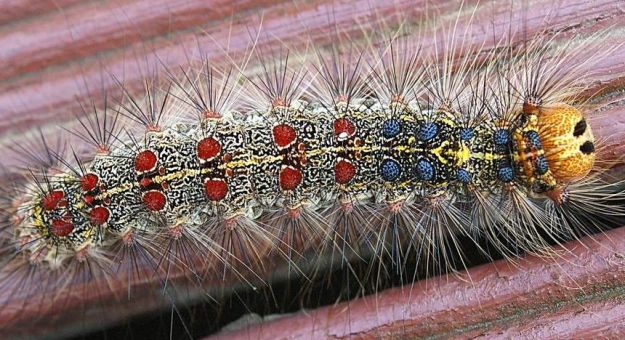
Gypsy Moth caterpillars will be active as soon as the GDD count hits 80-100. By all projections, that should happen around mid-May 8-10. The Gypsy moth is a generalist and will attack almost any shade tree and several evergreens such as pine and spruce. To manage small caterpillars, use Bt in the early going before switching to spinosad (Jack’s Dead Bug Brew) as the caterpillars get larger in size
GDD 80-100 Gypsy Moth Caterpillars
-
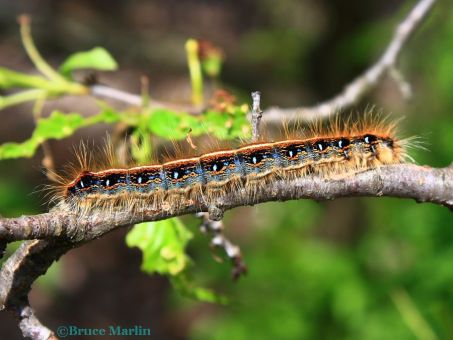
Eastern Tent Caterpillar caterpillars will be active as soon as the GDD count hits 80-100. By all projections, that should happen around Mid-May The ETC is host selective and only a threat to Black cherry, Malus and Prunus species. To manage small caterpillars, use Bt in the early going before switching to spinosad (Jack’s Dead Bug Brew) as the caterpillars get larger in size
GDD 80-100 Eastern Tent Caterpillar
-
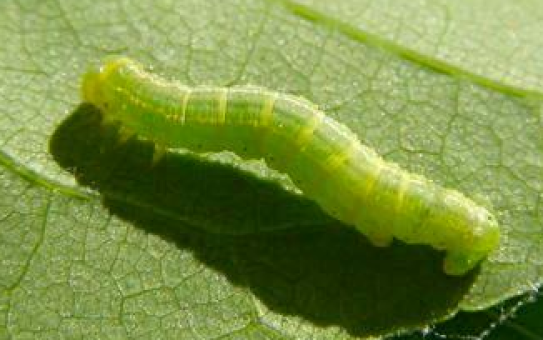
Winter moth caterpillars started hatching from eggs in early April. But their siting has been sporadic and their numbers extremely low so far this spring. Apply Bt for good control
GDD 80-280 Winter Moth Cateroillars
-
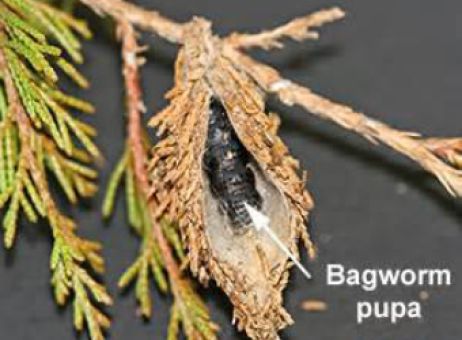 Bagworms have been increasing in numbers over the past decade and had a banner year in 2017. Check arborvitae, juniper, cypress and other evergreens for the presence of spindle-shaped bags attached to the foliage and twigs. Hand pick the bags and destroy, if possible, since they contain the eggs which will hatch into voracious feeding larvae in June (GDD 300)
Bagworms have been increasing in numbers over the past decade and had a banner year in 2017. Check arborvitae, juniper, cypress and other evergreens for the presence of spindle-shaped bags attached to the foliage and twigs. Hand pick the bags and destroy, if possible, since they contain the eggs which will hatch into voracious feeding larvae in June (GDD 300)GDD 300 Bagworm larvae
-
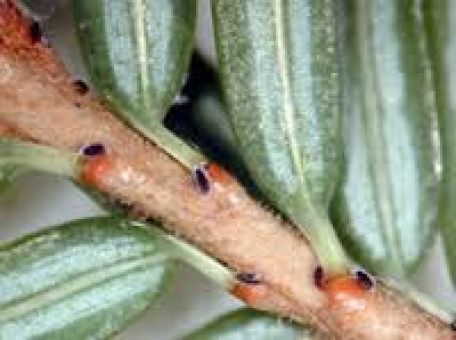
Hemlock Woolly Adelgid– Newly emerged crawlers of this insect pest are now searching for preferred feeding sites at the base of hemlock needles. As they search, they remain vulnerable to controlling measures. This window of control coincides with the calendar period mid to late July or when the Golden Raintree ( Kolreuteria paniculata) is actually blooming. An application of horticultural oil (summer rate), insecticidal soap, or a registered pesticide will be effective as long as crawlers are active.
Look for cotton swab-like cushions at the base of needles on hemlock. These are the female ovisacs of the Hemlock Wooly Adelgid (HWA).
GDD 800-1200 Hemlock Woolly Adelgid
-
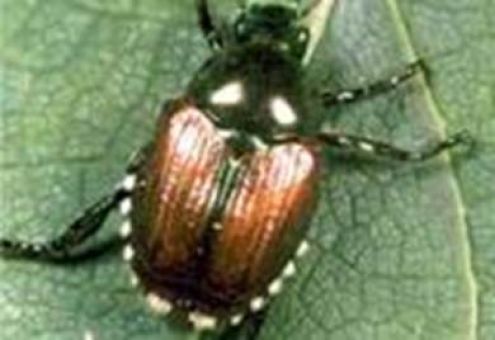
Japanese Beetle adults (1/2″ long, oval, metallic green body) will be feeding on tender leaves of most shade trees, roses and assorted shrubs from now until mid-August. Heavy infestations may lead to serious defoliation. Adult feeding is difficult to control. Weekly sprays in July of systemic insecticides such as imidacloprid (Bayer Advanced Complete Insect Killer) will provide some protection.
GDD 800-1300 Japanese Beetle
-
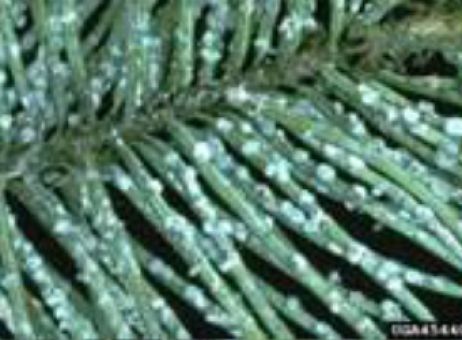 Cooley Spruce Gall Aphid– look for pine-apple-shaped galls caused by this adelgid on the terminal end of shoots of Colorado Blue Spruce. Prune them off before they open and place in 3% Chlorox solution before disposal.
Cooley Spruce Gall Aphid– look for pine-apple-shaped galls caused by this adelgid on the terminal end of shoots of Colorado Blue Spruce. Prune them off before they open and place in 3% Chlorox solution before disposal.GDD 800-1300 Cooley Spruce Gall Aphid
-
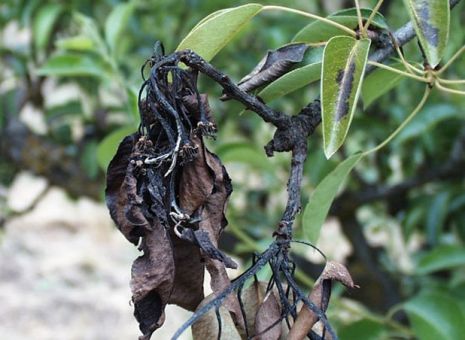 Fire Blight– a destructive bacterial disease of rosaceous plants (Malus and Prunus, etc.,), usually occurs during warm, wet periods in July and August. The disease strikes quickly causing leaves and twigs to shrivel turn brown and, then, black as if burnt with a torch. This disease is difficult to prevent. However, there are several simple ways to help avoid repeat disease outbreaks. They include:
Fire Blight– a destructive bacterial disease of rosaceous plants (Malus and Prunus, etc.,), usually occurs during warm, wet periods in July and August. The disease strikes quickly causing leaves and twigs to shrivel turn brown and, then, black as if burnt with a torch. This disease is difficult to prevent. However, there are several simple ways to help avoid repeat disease outbreaks. They include:- Using disease resistant plants
- Disposing of shedding leaves in fall
- Improving air circulation inside the canopy by pruning unnecessary foliage
- Cutting back to healthy tissue should disease symptoms occur.
GDD 800-1300 Fire Blight
-
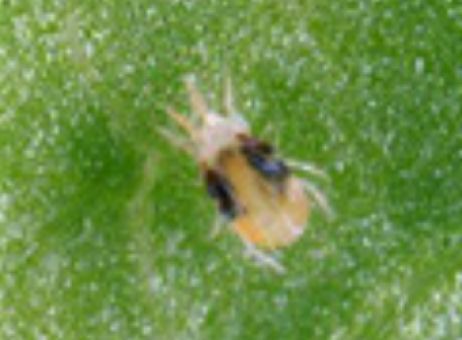
Two Spotted Spider Mite (honeylocust, spruce, azalea), Andromeda Lace Bug (azalea, rhododendron, andromeda), and Japanese beetle. Flecking, stippling and yellowing are the foliage damage symptoms of the first two. Treat them with horticultural oil or insecticidal soap. The latter will skeletonize the leaves. Limit damage by applying Sevin to host plants.
GDD 1400-2000 Two Spotted Spider Mite
-
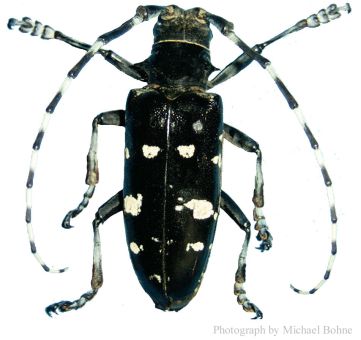
Asian Long-horned Beetle – August is also the peak month for adult ALB activity. Be familiar with the damage that they cause and how to distinguish the ALB adult beetle from the look-a-like native insects ( www.na.fs.fed.us/fhp/alb/. Report any potential finds to the local authorities at 866-702-9938.
GDD 1400-2000 Asian Longhorned Bettle
-
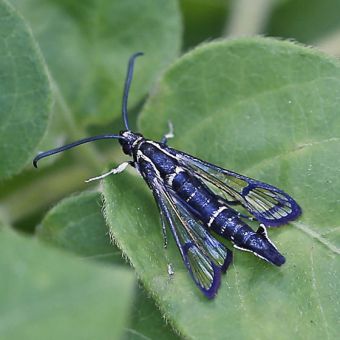
Peachtree Borer is a destructive pest of primarily Prunus species (peach, plum, cherry, etc.,). The adult (1″ clearwing moth with purplish black luster) will be actively laying eggs at the base of the trunk of susceptible hosts. Larvae will soon hatch to mine under the bark. Inspect lower trunks for wet spots or oozing. These are early signs of larval injury which can eventually lead to girdling of the stem and death of the plant. Treat trunks with residual pesticides such as Sevin nor permethrin. Also, avoid piling mulch against the trunk- it attracts egg-laying by this pest.
GDD 1400-2000 Peach Tree Borer
-
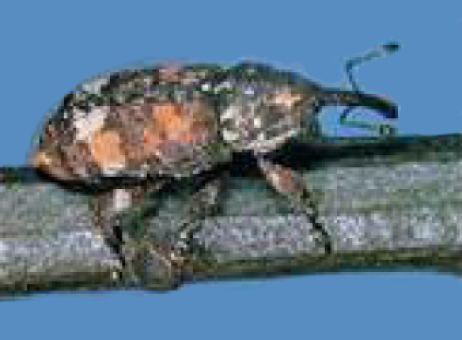
White Pine Weevil damage is now showing up as flagging leaders on White pine, spruce and other needled conifers. Cut out and destroy injured leaders. Next year apply an insecticide in spring after temperatures consistently reach 50 ˚F.
GDD 1400-2000 White Pine Weevil
-
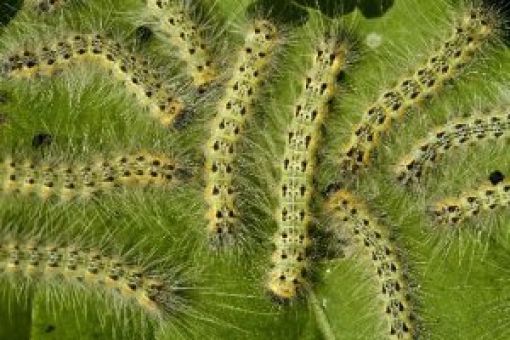
Fall Webworm is active now. Look for protective webbing on terminal ends of shade trees and other woody ornamentals. Remove webbing with hand pruning tools; Treat high level infestations with application of Spinosad (Jack’s Dead Brew Spray).
GDD 2200-3000 Fall Webworm
-
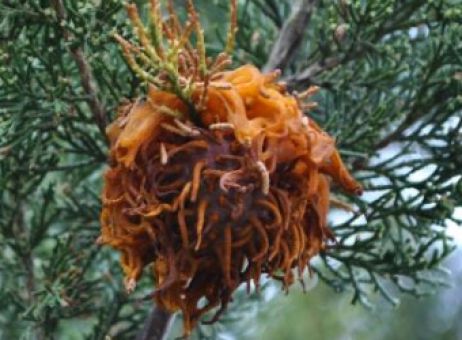
Orange colored walnut size balls are actually the spore emitting vessel of the fungus causing Cedar Apple Rust (CAR). This fungal disease attacks Malus species (apple, crabapple, etc.) and junipers (Juniperus species). Cool, wet weather actually influences disease outbreaks. The spore balls sometimes “grow” long, gelatinous tendrils. They emit spores infect Malus leaves, causing them to discolor and shed prematurely. Later, more spores will be produced by the apple to re-infect the juniper, keeping the infection cycle going. The walnut-like object in the picture is a dried down version of the gelatinous fungus. The best way to control this disease is to plant disease resistant apple trees and to NOT plant red cedar where apples are present.
Gelatinous Tendrils
-
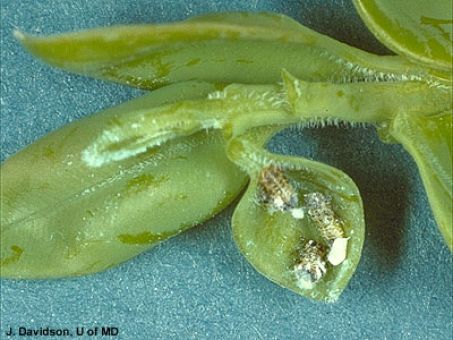 Now is the period to check Boxwoods for the presence of mites and psyllids. Immature mites are yellow-tan in color with many legs.
Now is the period to check Boxwoods for the presence of mites and psyllids. Immature mites are yellow-tan in color with many legs.Mites and Psyllids
-
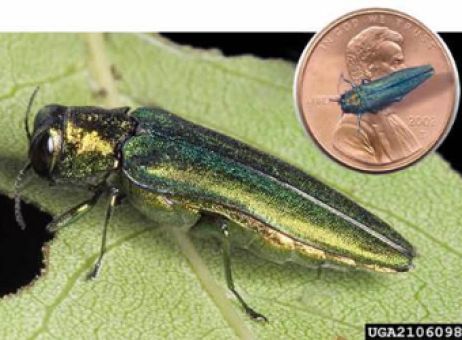 Emerald ash borer adults are narrow-bodied, ¼- ½” long with metallic green wing color. They attack several species and cultivars of ash.
Emerald ash borer adults are narrow-bodied, ¼- ½” long with metallic green wing color. They attack several species and cultivars of ash.Emerald ash borer
-
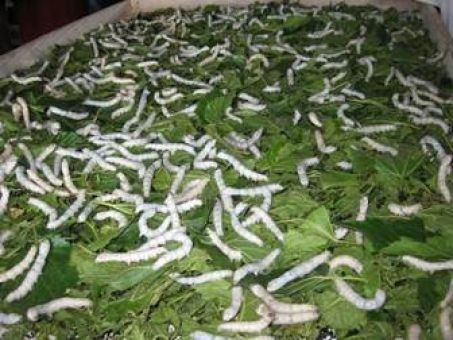 Look for pale-yellow caterpillars hanging down on silken threads between feeding on leaves of Red, Black, Pin and Willow oaks.
Look for pale-yellow caterpillars hanging down on silken threads between feeding on leaves of Red, Black, Pin and Willow oaks.Oak Skeletonizer
-
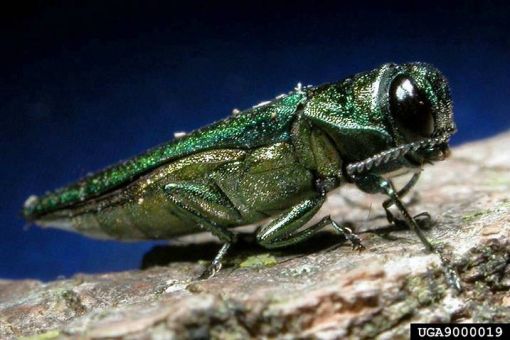 (EAB)- This killer of ash, has been found in New York, Connecticut and Massachusetts but not yet in Rhode Island.
(EAB)- This killer of ash, has been found in New York, Connecticut and Massachusetts but not yet in Rhode Island.
This has not stopped, however, the RIDEM -Division of Agriculture of deploying numerous EAB traps across the state in 2013 as part of an early detection strategy. The traps are designed to lure the bright, metallic green, ½” long adult beetles to them during the pests’ emergence period from mid-July until the end of August.
Besides the adult beetle, look for signs of infestation to help with its detection. These include canopy die back at the top of ash trees, sprouting of shoots along the trunk, D-shaped exit holes and S-shaped galleries made by EAB larvae under the bark of the plant.
Contact the RIDEM- Department of Agriculture at 401-222-2281 or the USDA-FS Hotline at 866-702-9938.Emerald Ash Borer
-
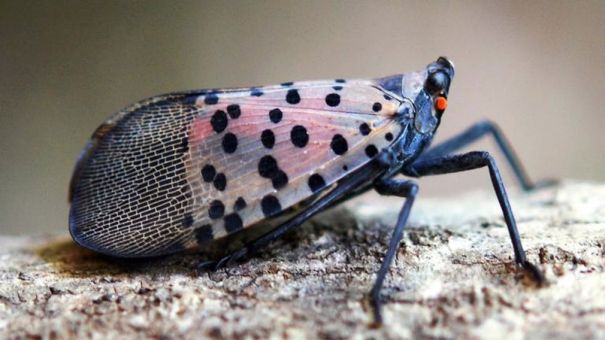
SLF was discovered attacking trees and shrubs along Route 7 in Smithfield, RI in late August 2022. Other infestations have since been found in Lincoln and North Providence. RIDEM has been using the USDA approved pesticide Bifenfrin to kill adults at known infested sites. The spraying started in September and continued through the first week of November. The goal is to contain the spread of this lethal pest as much as possible. To learn more about SLF, visit www.dem.ri.gov/agriculture/caps-program-pests.
Spotted Laternfly
2023 WEATHER SUMMARY BY COMMUNITY*
BRISTOL
|
MONTH |
AVE TEMP °F |
AVE SOIL °F |
GDD/ YTD |
RAIN”/ YTD |
RAIN DAYS/ YTD |
|
April |
53 |
53 |
127/ 127 |
4.1/ 4.1 |
09 |
|
May |
59 |
62 |
288/ 415 |
3.2/ 7.3 |
05/ 14 |
|
June |
67 |
70 |
499/ 914 |
4.1/ 11.4 |
11/ 25 |
|
July |
76 |
78 |
814/ 1728 |
7.8/ 19.2 |
10/ 35 |
|
August |
|||||
|
September |
|||||
|
October |
CUMBERLAND
|
MONTH |
AVE TEMP °F |
AVE SOIL °F |
GDD/ YTD |
RAIN”/ YTD |
RAIN DAYS/ YTD |
|
April |
54 |
64 |
161/ 161 |
3.0/ 3.0 |
05/ |
|
May |
61 |
73 |
336/ 497 |
5.3/ 8.3 |
07/ 12 |
|
June |
69 |
76 |
527/ 1024 |
3.9/ 12.2 |
12/ 24 |
|
July |
79 |
84 |
850/ 1874 |
9.1/ 21.3 |
13/ 37 |
|
August |
|||||
|
September |
|||||
|
October |
FOSTER
|
MONTH |
AVE TEMP °F |
AVE SOIL °F |
GDD/ YTD |
RAIN”/ YTD |
RAIN DAYS/ YTD |
|
April |
52 |
122/ 122 |
4.3/ 4.3 |
07/ |
|
|
May |
52 |
126/ 248 |
4.3/ 8.6 |
04/ 11 |
|
|
June |
64 |
401/ 649 |
4.4/ 13.0 |
06/ 17 |
|
|
July |
74 |
772/ 1421 |
9.0/ 22.0 |
08/ 25 |
|
|
August |
|||||
|
September |
|||||
|
October |
KINGSTON
|
MONTH |
AVE TEMP °F |
AVE SOIL °F |
GDD/ YTD |
RAIN”/ YTD |
RAIN DAYS/ YTD |
|
April |
52 |
109/ 109 |
4.5/ 4.5 |
11/ |
|
|
May |
56 |
215/ 324 |
4.8/ 9.3 |
08/ 19 |
|
|
June |
65 |
463/ 787 |
4.1/ 13.4 |
09/ 28 |
|
|
July |
75 |
777/1564 |
6.0/ 19.4 |
12/ 40 |
|
|
August |
|||||
|
September |
|||||
|
October |
MIDDLETOWN
|
MONTH |
AVE TEMP °F |
AVE SOIL °F |
GDD/ YTD |
RAIN”/ YTD |
RAIN DAYS/ YTD |
|
April |
51 |
56 |
84 |
3.7/ 3.7 |
07 |
|
May |
|||||
|
June |
65 |
75 |
445 |
3.8 |
07 |
|
July |
|||||
|
August |
|||||
|
September |
|||||
|
October |
NEWPORT
|
MONTH |
AVE TEMP °F |
AVE SOIL °F |
GDD/ YTD |
RAIN”/ YTD |
RAIN DAYS/ YTD |
|
April |
52 |
49 |
104/ 104 |
3.8/ 3.8 |
05/ |
|
May |
58 |
66 |
241/ 345 |
1.7/ 5.5 |
03/ 08 |
|
June |
65 |
67 |
464/ 809 |
3.5/ 9.0 |
08/ 16 |
|
July |
|||||
|
August |
|||||
|
September |
|||||
|
October |
NORTH SMITHFIELD
|
MONTH |
AVE TEMP °F |
AVE SOIL °F |
GDD/ YTD |
RAIN”/ YTD |
RAIN DAYS/ YTD |
|
April |
50 |
52 |
118/ 118 |
3.2/ 3.2 |
05/ |
|
May |
57 |
60 |
288/ 406 |
4.8/ 8.0 |
04/ 09 |
|
June |
65 |
67 |
441/ 847 |
4.1/ 12.1 |
10/ 19 |
|
July |
75 |
73 |
770/ 1617 |
9.1/ 21.2 |
10/ 29 |
|
August |
|||||
|
September |
|||||
|
October |
NORTH PROVIDENCE
|
MONTH |
AVE TEMP °F |
AVE SOIL °F |
GDD/ YTD |
RAIN”/ YTD |
RAIN DAYS/ YTD |
|
April |
55 |
52 |
251 |
||
|
May |
64 |
59 |
439/ 690 |
||
|
June |
69 |
64 |
571/1261 |
5.2 |
07 |
|
July |
|||||
|
August |
|||||
|
September |
|||||
|
October |
PROVIDENCE
|
MONTH |
AVE TEMP °F |
AVE SOIL °F |
GDD/ YTD |
RAIN”/ YTD |
RAIN DAYS/ YTD |
|
April |
51 |
90/ 90 |
3.5/ 3.5 |
06/ |
|
|
May |
58 |
269/ 359 |
5.3/ 8.8 |
07/ 13 |
|
|
June |
63 |
393/ 752 |
3.5/ 12.3 |
14/ 27 |
|
|
July |
74 |
744/ 1496 |
8.4/ 20.7 |
13/ 40 |
|
|
August |
|||||
|
September |
|||||
|
October |
PRUDENCE ISLAND
|
MONTH |
AVE TEMP °F |
AVE SOIL °F |
GDD/ YTD |
RAIN”/ YTD |
RAIN DAYS/ YTD |
|
April |
52 |
96/ 96 |
3.5/ 3.5 |
09/ |
|
|
May |
57 |
236/ 332 |
5.7/ 9.2 |
07/ 16 |
|
|
June |
|||||
|
July |
76 |
768 |
|||
|
August |
|||||
|
September |
|||||
|
October |
RICHMOND
|
MONTH |
AVE TEMP °F |
AVE SOIL °F |
GDD/ YTD |
RAIN”/ YTD |
RAIN DAYS/ YTD |
|
April |
53 |
130/ 130 |
4.3/ 4.3 |
||
|
May |
54 |
53 |
271/ 401 |
5.4/ 9.7 |
04/ |
|
June |
70 |
70 |
603/ 1004 |
7.7/ 17.4 |
06/ |
|
July |
|||||
|
August |
|||||
|
September |
|||||
|
October |
SMITHFIELD
|
MONTH |
AVE TEMP °F |
AVE SOIL °F |
GDD/ YTD |
RAIN”/ YTD |
RAIN DAYS/ YTD |
|
April |
|||||
|
May |
57 |
54 |
234 |
1.7 |
04 |
|
June |
64 |
58 |
416 |
4.4 |
10 |
|
July |
|||||
|
August |
|||||
|
September |
|||||
|
October |
SOUTH KINGSTOWN
|
MONTH |
AVE TEMP °F |
AVE SOIL °F |
GDD/ YTD |
RAIN”/ YTD |
RAIN DAYS/ YTD |
|
April |
53 |
56 |
136/ 136 |
5.0/ 5.0 |
05/ |
|
May |
59 |
62 |
276/ 412 |
4.7/ 9.7 |
03/ 08 |
|
June |
66 |
66 |
485/ 897 |
5.1/ 12.8 |
06/ 14 |
|
July |
76 |
76 |
774/ 1671 |
6.2/ 19.0 |
07/ 21 |
|
August |
|||||
|
September |
|||||
|
October |
WESTERLY
|
MONTH |
AVE TEMP °F |
AVE SOIL °F |
GDD/ YTD |
RAIN”/ YTD |
RAIN DAYS/ YTD |
|
April |
50 |
68/ 68 |
2.9/ 2.9 |
08/ |
|
|
May |
57 |
226/ 294 |
4.0/ 6.9 |
07/ 11 |
|
|
June |
64 |
483/ 777 |
3.1/ 10.0 |
10/ 21 |
|
|
July |
73 |
725/ 1502 |
5.2/ 15.2 |
11/ 32 |
|
|
August |
|||||
|
September |
|||||
|
October |
RHODE ISLAND AVERAGE
|
MONTH |
AVE TEMP °F |
AVE SOIL °F |
GDD/ YTD |
RAIN”/ YTD |
RAIN DAYS/ YTD |
|
April |
52 |
54 |
112/ 112 |
4.1/ 4.1 |
07/ |
|
May |
58 |
63 |
246/ 358 |
4.1/ 8.2 |
05/ 12 |
|
June |
66 |
69 |
483/ 841 |
4.4/ 12.6 |
09/ 21 |
|
July |
75 |
76 |
774/ 1615 |
7.8/ 20.4 |
10/ 31 |
|
August |
|||||
|
September |
|||||
|
October |
*This summary report is produced from daily weather data collected by volunteers at their place of residence. We appreciate their tireless efforts. They have helped us to publish informative plant care alerts in RI Tree’s monthly newsletter ROOT TIPS. They are Michael Emma, David Brown, Kathleen Campanini, Deborah Vine-Smith, Craig Hotchkiss, Aaron Lavoie, Terry Meyer, Joseph Jamroz, David Flanders, Andy Sabo, Glenn Rawson, Tim Sherman, Patricia Cass, Lee Wyman, Joan Pelletier, William DeMarco, Angelyn Phillips, and William Carroll. Want to become a Weather Project Volunteer? Contact us at ritree@ritree.org.